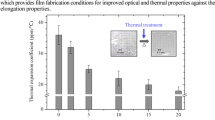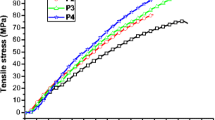Abstract
Optical anisotropy of thin films of an organo-soluble flexible polyimide based on 1,4-bis(3,4-dicarboxyphenoxy) benzene dianhydride (HQDPA) and 2,2-dimethyl-4,4′-methylene dianiline (DMMDA) was detected by a prism-coupler technique. A mechanism is proposed, based on the model of gel film collapse. The degrees of optical anisotropy of the thin films were evaluated via the level of negative birefringence. The residual solvent in the films lessens the levels of negative birefringence so that the residual solvent must be evacuated. The levels of negative birefringence are independent on the solid content of the initial solution, but dependent on the thickness of the films. For a film of 16 μm thick, zero birefringence was achieved, postulated from the dependence of negative birefringence on the thickness of thin films. The relationship between the optical anisotropy and solution properties shows that the degrees of optical anisotropy of thin films on the same scale of thickness depend on macromolecular sizes in their dilute solutions.
Similar content being viewed by others
References
C. R. Sroog, Prog. Polym. Sci. 16, 561 (1991).
T. P. Russell, H. Gugger, and J. D. Swalen, J. Polym. Sci.: Polym. Phys. Ed. 21, 1745 (1981).
L. Lin and S. A. Bidstrup, J. Appl. Polym. Sci. 49, 1277 (1993).
S. Herminghaus, D. Boese, D. Y. Yoon, and B.A. Smith, Appl. Phys. Lett. 59, 1043 (1991).
M. Hasegawa, T. Matano, Y. Shindo, and T. Sugimuro, in Polymeric Materials for Microelectronic Applications, edited by H. Ito, S. Tagawa, and K. Horie (ACS Symposium Series 579, Washington, DC, 1994), p. 234.
J. Joum, P. Huang, H. Chen, and C. Liao, Polymer 38, 967 (1992).
M. T. Pottiger, J. C. Coburn, and J. R. Edman, J. Polym. Sci.: Polym. Phys. Ed. 32, 825 (1994).
J. C. Coburn and M.T. Pottiger, in Polyimides: Fundamentals and Applications, edited by M. K. Ghosh and K.L. Mittal (Marcel Dekker, Inc., New York, 1996), pp. 207–247.
B. Li, T. He, M. Ding, H. Hu, and C. Wu, Polymer (in press).
P. J. Flory, Statistical Mechanics of Chain Molecules (Wiley-Interscience, New York, 1969).
D. W. Van Krevelen, Properties of Polymers: Their Estimation and Correlation with Chemical Structure (Elsevier Scientific Publishing Company, Amsterdam, 1970).
R. Ikeda, J. Polym. Sci.: Polym. Lett. 4, 353 (1966).
P. J. Flory, Principle of Polymer Chemistry (Cornell University Press, Ithaca, NY, 1953).
Author information
Authors and Affiliations
Corresponding author
Rights and permissions
About this article
Cite this article
Li, B., He, T., Ding, M. et al. Optical anisotropy of flexible polyimide thin films. Journal of Materials Research 13, 1368–1372 (1998). https://doi.org/10.1557/JMR.1998.0194
Received:
Accepted:
Published:
Issue Date:
DOI: https://doi.org/10.1557/JMR.1998.0194




